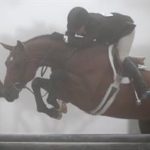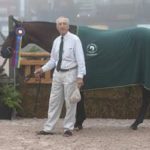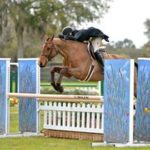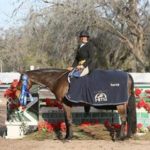Have you ever watched a big, competitive hunter class and come away scratching your head about why the judge pinned one trip above another? Or have you heard other onlookers blame politics or favoritism for a particular horse always placing well? Most people agree when exceptionally beautiful rounds deserve to win classes. It’s sorting out the placings among trips of similar quality that challenges judges and sometimes creates spectator confusion about the judging process.
 This is what a judge looks for in a winning hunter performance: a completely relaxed horse jumping in great style with a round shape, his shoulder raised high and his knees almost even with a beautiful expression. Zurich’s sincere look tells me he’s happy to do his job and has total faith in his rider, Jimmy Torano, who also looks very relaxed and is clearly following Zurich’s motion.
This is what a judge looks for in a winning hunter performance: a completely relaxed horse jumping in great style with a round shape, his shoulder raised high and his knees almost even with a beautiful expression. Zurich’s sincere look tells me he’s happy to do his job and has total faith in his rider, Jimmy Torano, who also looks very relaxed and is clearly following Zurich’s motion.At a recent Florida show, for example, I judged a large class in which the winner scored a 92 and the 12th-placed horse scored an 87. Judging rides this similar in quality is more than just a matter of looking for eight nice jumps and ticking off every little mistake each horse makes. Yes, we take these mistakes into consideration, but what matters most is the overall impression the horse and rider give us.
The ultimate question I try to answer when watching a trip is: “Would I like to ride this horse or teach a student on him?” Because different judges prefer riding and teaching on different types of horses, our choices do vary slightly. However, I believe that most of us try to follow established, uniform standards and work our hardest to make fair, unbiased decisions. To understand how we arrive at these decisions, you need to watch every trip in every class from the judge’s perspective. In this article, I’ll tell you how to put yourself in our shoes and see what we’re looking for. Then I’ll offer some tips for how to produce that winning performance.
What Makes a Winning Trip
I try to focus on the positive aspects of every trip as I formulate my judgment. I like to think that every horse can achieve a score of about 80 with a basically nice round. The scores go up from there depending on how impressive a horse’s style and performance are.
Here’s how I’d describe a round scoring 90 or above: Overall, it should give you the impression of being effortless. It should flow smoothly from one beautiful jump to the next with no changes in pace or rhythm. Each jumping effort should be stylish, athletic and lofty. I like to see a horse lift his forelegs from his shoulders, raising his forearms high and folding his lower legs tightly. He should come off the ground slowly and spend time in the air. His neck should extend as he goes over the fence and, on landing, he should continue forward in a strong, reaching stride, resuming the same rhythm he had in the approach. The lead changes should appear to occur naturally, without disrupting the flow. And each distance should work out almost magically, as if the rider didn’t even have to think about it.
A winning hunter should also exhibit an enthusiastic, confident expression. Everything about his demeanor—the energy he puts into his gallop and jumping efforts, the way he reacts to the rider— should indicate he enjoys his job. I want to see his ears pricked as he approaches the fences. If he pins them, wrings his tail or kicks out, he won’t earn as high a score as a more-pleasant-appearing horse. On the other hand, I don’t mind if he shakes his head playfully once or twice, especially in a Green division. I’d rather see him enjoying his job than looking dull and drilled. (If he shakes his head frequently, however, that may indicate he’s too fresh.)
If the overall picture is smooth, beautiful and exciting to watch, I don’t overly penalize little mistakes, such as a late lead change. However, if something about the horse’s performance nags at my subconscious throughout the trip—even something iffy that’s difficult to define exactly—I can’t reward him with a high score. For example, if he gives me the impression of being stiff at the beginning of the trip and I can’t shake that feeling by the end of it, I won’t score him as high as a horse who appears loose, limber, athletic and free in his movement.
What Your Riding Is Telling the Judge
Although your position and technical riding skills don’t affect your score directly in hunter classes the way they do in equitation classes, your riding does matter. The judge wants to see you riding effectively enough to show off your horse’s best attributes while also staying quiet in your body and subtle in your aids so as not to distract the judge’s eye from your horse.
One factor many onlookers may not realize judges are considering is the amount of trust a horse and rider demonstrate in one another. This is evident in the actions a rider makes in the saddle to try to influence her horse. A winning trip shouldn’t look manufactured. Rather than working visibly to get your horse right to every jump, you should appear simply to allow him to do it. You want to make him look like a genius.
For example, a rider who constantly tugs on the reins gives me the impression her horse is lugging or heavy in the bridle. A rider who keeps her upper body at or behind the vertical makes me think she doesn’t trust her horse to stay in balance to the jumps. Excess body action—rocking in the saddle, stirring the elbows and generally moving around too much—tells me that this horse is a lot of work to ride. Even if the result is a decent, correct round, this rider may score only an 82, whereas a rider who produced a similar trip and made it look easy might score an 88.
A rider who protects her horse to every jump, holding a strong contact in the approach and even keeping a feel in the takeoff to try to help his effort, will not score as well as a rider who softens her arm in the approach, leaving the jump up to the horse. I’m even more impressed by a rider who trusts her horse to get himself out of a tricky spot—for example, if he gets a little too close to the jump in the takeoff. If she stays slightly closed in her hip angle, softens the reins and he still produces a smooth, beautiful jump, I’ll score that higher than a rider who opens up from the hip 3 inches and keeps firm pressure on the reins for fear that her horse might tip his front end or lose his straightness.
Although I look for these qualities in every winning round, I may weight them slightly differently depending on the class title, so the horse who is most suitable for the job he’s expected to do comes out on top. For example, in a Children’s or Amateur class, I reward a horse who appears safe and reliable and tries to take care of his rider. In the high-performance classes, I look for an extremely athletic, stylish horse. And I’ll be more forgiving of minor mistakes in the First Year Green classes.
 Smooth Landings: A good rider’s job doesn’t end midair over the fence. It’s essential that you allow your horse to complete his jump smoothly and gallop away on landing. Jimmy Torano is following Zurich’s motion to the ground, staying closed in his hip angle and letting Zurich’s neck extend freely forward. As a result, Zurich looks very comfortable and unrestricted. This is how you get the horse to be on your team. When he trusts you not to override or interfere with any phase of his jump, he’ll do his best to help you get the job done right.
Smooth Landings: A good rider’s job doesn’t end midair over the fence. It’s essential that you allow your horse to complete his jump smoothly and gallop away on landing. Jimmy Torano is following Zurich’s motion to the ground, staying closed in his hip angle and letting Zurich’s neck extend freely forward. As a result, Zurich looks very comfortable and unrestricted. This is how you get the horse to be on your team. When he trusts you not to override or interfere with any phase of his jump, he’ll do his best to help you get the job done right. Preparing for Your Best Round
So what can you do as a rider to produce a winning round? Having a horse with terrific natural ability and jumping style, a willingness to perform and enthusiasm for the job is key. But there’s a lot you can do at home, in the warm-up and in the ring to make him stand out in the judge’s mind. At home, train yourself to stay out of your horse’s way when he’s jumping and resist trying to protect or help him. If you maintain a light rein contact in the approaches to the fences and he makes a mistake, he’ll learn from it. But if you pull on the reins or move around dramatically in the saddle, he’ll spend less time in the air and will begin to think negatively about you. You want to keep him on your team!
Also focus on riding the horse you’re on each day, not the horse you rode yesterday or the one who won or lost a class in his last show. Horses are just like us: They have good days and bad days. Start each day with a clean slate and, however your mount is feeling, try to help him be the horse you love.
In the warm-up at the show, try to correct him without upsetting him. If he sticks off the ground, tap him behind the saddle before the jump or on landing. If he’s sluggish, rev up his gallop a little. Then reward him for improving and get back to working as a team.
Some horses get a little dull or heavy in the bridle jumping the plain schooling fences in the warm-up over and over. To sharpen your horse a little, instead of giving him 12 to 15 strides in every approach, practice making a shorter turn to the jump, first from about seven or eight strides away. Bend him around the turn, straighten him, then relax your arm. If he remains heavy in the bridle and feels as if he’s going past the ideal distance, don’t try to protect him. Let him learn from his mistakes. The next time, make an even shorter turn, about four or five strides away from the fence.
 A Shorter Turn: In long approaches to fences, horses sometimes lose their concentration and fail to focus properly on the jump. By practicing shorter turns in your approaches, you can teach your horse to get his eye on the next jump earlier. Quiz’s pricked ears and focused expression here show that he’s locked his gaze onto the next jump. Elena is doing a great job following his motion with a very light rein so she doesn’t interfere at all with the flow of his canter or his nice, happy expression.
A Shorter Turn: In long approaches to fences, horses sometimes lose their concentration and fail to focus properly on the jump. By practicing shorter turns in your approaches, you can teach your horse to get his eye on the next jump earlier. Quiz’s pricked ears and focused expression here show that he’s locked his gaze onto the next jump. Elena is doing a great job following his motion with a very light rein so she doesn’t interfere at all with the flow of his canter or his nice, happy expression. To polish your horse’s jumping technique before entering the ring, warm up over a vertical and then progress to a ramped oxer. This will encourage him to rotate his shoulder higher over the jump. Be sure to follow him in the air, keeping your hip closed and offering him a soft rein release, so he feels safe to follow through with a big, beautiful effort. Then square up the oxer to help him “back up”—maintain his balance over his hocks— in the approach to the jumps. Be careful not to drill. You don’t want to use up your horse’s best efforts in the warm-up ring.
Maximize Your Score
From the moment you enter the ring, think about the impression you’re giving the judge. I’m not overly concerned about the opening circle, so long as you don’t swerve all over the place and it doesn’t take you all day to make it. What I do want to see is a pleasant, confident attitude that says, “I’m here to do my job, and I’m going to show you what my horse can do.” Enter in a forward, active trot, not a mincing trot that’s so slow I can’t tell if your horse is a good mover or not.
When you pick up the canter, establish a nice pace and rhythm right away and head to the first jump in a forward, positive manner. This shows that you trust your horse and makes the judge want to root for him throughout the rest of the course. If you start more tentatively, waiting to find your distance before picking up the pace, you miss your chance to make a great first impression. Remember: The first jump counts just as much as the last.
Relax your rein contact in front of the fences to show the judge how much you trust your horse. The jump is his job, not yours. There is nothing you can do at this point to make it better. And overriding— holding the reins or kicking and spurring— will make your horse quick in the air and distract him from his job. As he takes off, let him absorb into your position and follow his neck with your arms. Stay closed in your hips and as quiet in your upper body as possible, giving him time to complete the jump, land fluidly and continue on to the next fence.
If any adjustments need to be made on course—a little rebalancing between your leg and hand, steadying the rhythm or giving a quick kick to get his motor going— try to make them in the most discreet way possible, where the judge is least likely to notice. The best place is in a far corner going away from the judge. I love to see a horse sail smoothly out of every turn in a continuous, forward stride, without the rider holding him back, waiting to see the distance. If it’s necessary to make adjustments in a line, do them as early and as subtly as possible, so you can sit quietly and soften your hands in front of the next fence.
In general, I don’t believe the show ring is the place to do your training. However, it’s occasionally necessary to exaggerate your riding to correct a bad habit. For example, if your horse starts to swap leads in front of his fences, you may need to exaggerate your aids to hold the lead in the approach and then ride a little to the outside for a few strides afterward to make him wait for your cue to change. As a rider myself, I understand why you might need to do this, but I can’t place your performance, no matter how technically correct it might be, over an equally correct trip of another rider who didn’t have to work so hard to ensure that it went well.
Try to finish the course with the same positive, confident attitude that you started with, showing the judge that, no matter what has happened in the interim, you still trust your horse to gallop down to the last fence and make a beautiful jump without any visible help from you. If you finish with a sense of exhilaration and satisfaction that he gave you his best, most athletic performance in a way that felt effortless to both of you—and if the smile on your face is reflected in a happy expression on his face, most likely the judge will have enjoyed the performance just as much as you. That’s how you achieve a winning trip!
About Danny Robertshaw and Ron Danta
 Danny Robertshaw (left) and Ron Danta
Danny Robertshaw (left) and Ron DantaDanny Robertshaw has trained and competed show hunters for more than 35 years, winning numerous championships at the Devon Horse Show, the Pennsylvania National Horse Show, the Washington International Horse Show and the National Horse Show. He also has judged at Devon, Washington, the USEF Pony Medal Final and the USHJA International Hunter Derby Finals multiple times, as well as at the National Horse Show. He has served on the USHJA High Performance and Officials Committees and the USEF Licensed Officials Committee and has conducted more than 25 judges clinics.
Danny and his partner, Ron Danta, also run a nationally recognized pet-rescue organization. Working with their local humane society and animal shelters in Camden, South Carolina, and Wellington, Florida, they have helped to raise money to house sick and injured animals. They have also placed more than 5,600 animals in new homes. To learn more, find Danny & Ron’s Rescue on Facebook or go to www.dannyandronsrescue.org.
This article originally appeared in the July 2013 issue of Practical Horseman.















